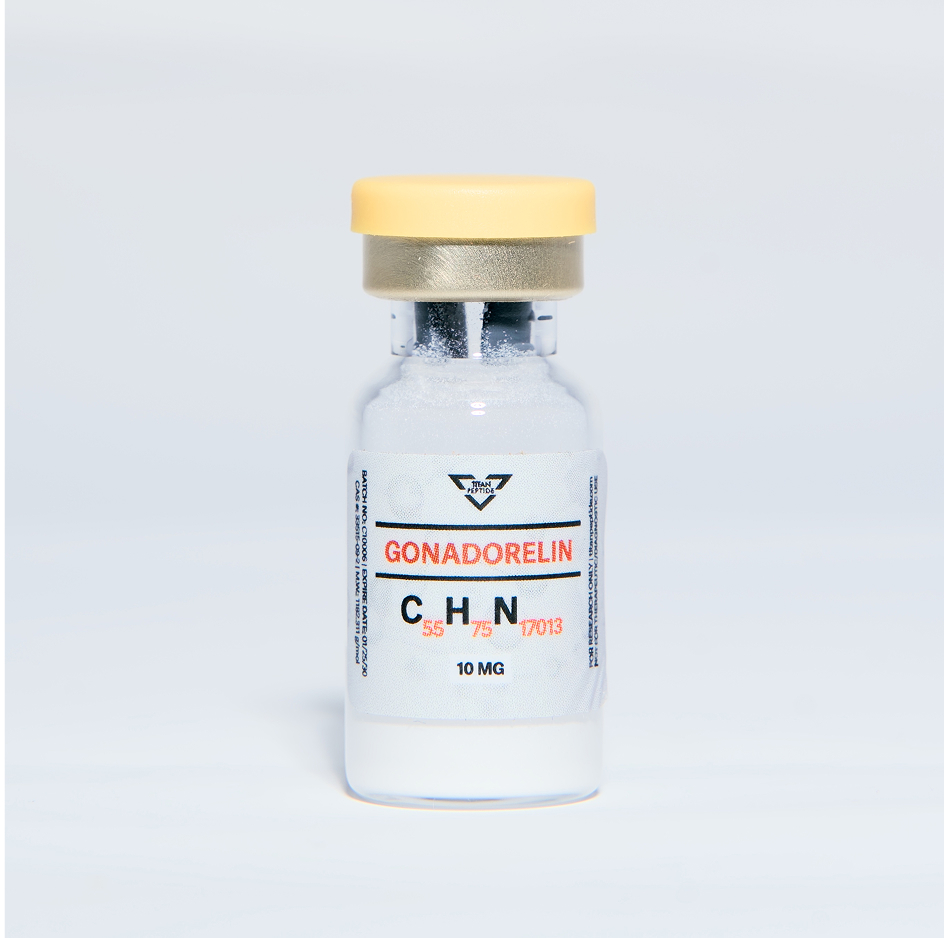

GONADORELIN
Gonadorelin is a decapeptide that is chemically identical to endogenous gonadotropin-releasing hormone, produced in the hypothalamus. In experimental models, it stimulates the anterior pituitary to release luteinizing hormone (LH) and follicle-stimulating hormone (FSH), which are critical in regulating reproductive physiology.





A synthetic analog of natural gonadotropin-releasing hormone (GnRH), modeled for laboratory research.
Gonadorelin is a decapeptide that is chemically identical to endogenous gonadotropin-releasing hormone, produced in the hypothalamus. In experimental models, it stimulates the anterior pituitary to release luteinizing hormone (LH) and follicle-stimulating hormone (FSH), which are critical in regulating reproductive physiology.
In research, Gonadorelin is used to investigate reproductive endocrinology, hypothalamic–pituitary–gonadal (HPG) axis function, and the effects of GnRH analogs on hormonal signaling. It can be administered in pulsatile or continuous patterns, producing markedly different physiological effects — a feature that is valuable in controlled studies of hormone regulation.

Titan research and immune system function
Reproductive Hormone Regulation:
Studied for its ability to trigger LH and FSH release, simulating normal hypothalamic signaling.
HPG Axis Diagnostics:
Used experimentally to evaluate pituitary responsiveness in endocrine function studies.
Fertility & Puberty Research:
Investigated in models examining the onset of puberty, ovulation, and spermatogenesis.
Hormonal Feedback Studies:
Useful for studying how sex hormones influence hypothalamic and pituitary activity.
Pulsatile vs. Continuous Release Models:
Research distinguishes between stimulation patterns that enhance or suppress gonadotropin release.
Titan research and immune system function
Pituitary Stimulation:
Directly activates GnRH receptors in the anterior pituitary, leading to gonadotropin release.
Reproductive Cycle Mapping:
Facilitates controlled studies on ovulatory and spermatogenic cycles in animal models.
Feedback Loop Analysis:
Allows precise examination of hormonal feedback on the hypothalamus–pituitary–gonadal axis.
(1) Wang F., et al. (2022) Pulsatile GnRH therapy improves fertility hormone levels in hypogonadotropic patients. → Demonstrated >150% LH increase after 1 week, rising through week 4. [Shanghai Jiao Tong Univ Med Journal]
(2) Matsumoto, A. M., et al. (1986) Long-term gonadorelin administration sustains elevated LH and FSH. → Showed continued LH elevation at week 4 in healthy and hypogonadal subjects. [PubMed ID: 1955518]
.svg)
The chart shows the effects of Gonadorelin on LH (luteinizing hormone) stimulation over four weeks in human clinical data. Starting at Week 1, LH secretion increased by about 150%, rising further to 200% by Week 2.
By Week 4, LH levels reached a 250% increase, highlighting a steady upward trend. This suggests that Gonadorelin produces a strong and progressive boost in hormone secretion with continued use.
Form:
Lyophilized Powder
Storage (unreconstituted):
- Store at 2–8 °C (refrigerated), protected from light.
- For long-term storage, keep at –20 °C.
- Avoid repeated freeze–thaw cycles.
Reconstitution:
- Reconstitute with sterile water for injection or 0.9% NaCl immediately prior to use. Use aseptic technique.
Storage (after reconstitution):
- Store at 2–8 °C.
- Use within 7–10 days.
- Discard any unused solution after this period.
- Handle under sterile conditions.
- Do not shake vigorously (may cause peptide denaturation).
- Inspect visually for particulate matter or discoloration before use.
Issued for quality verification of tested material.
Feedback highlighting proven outcomes and reliability.













